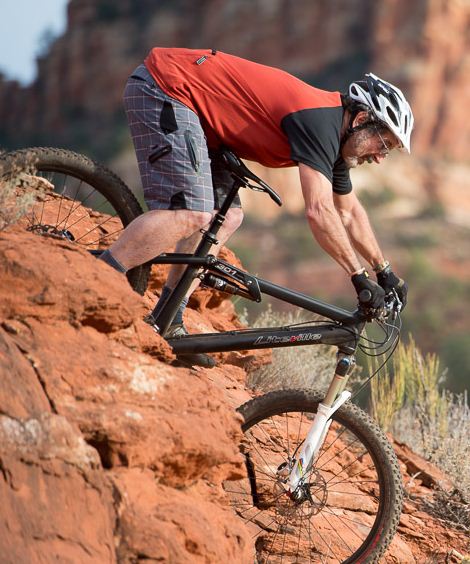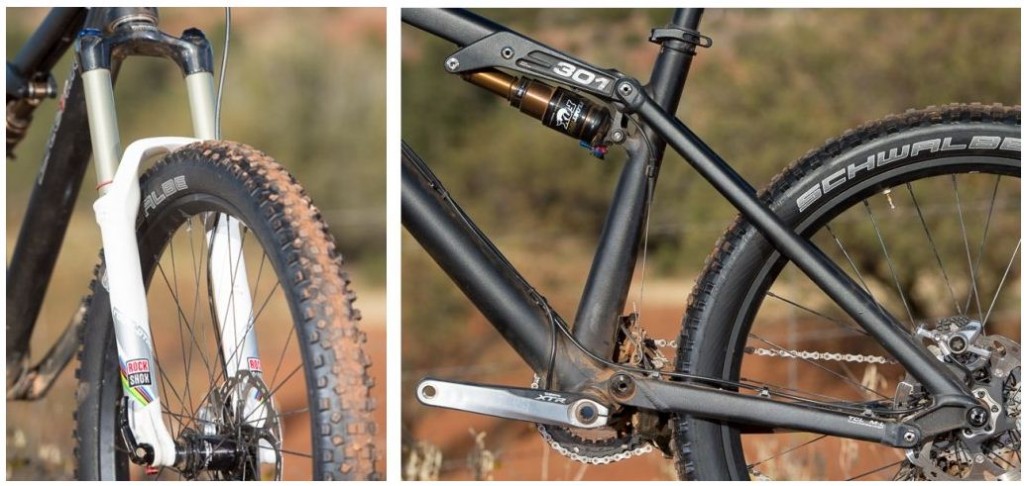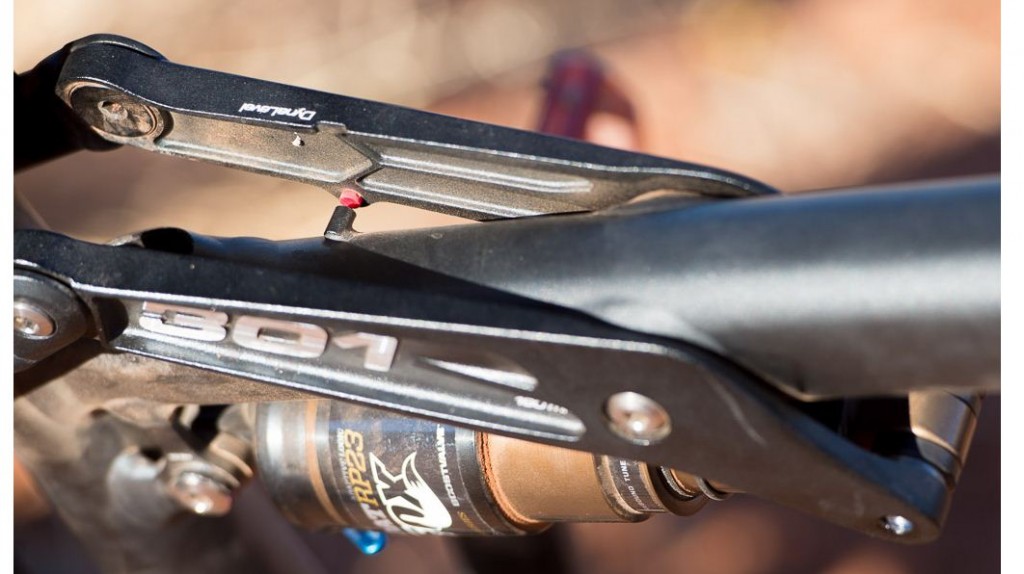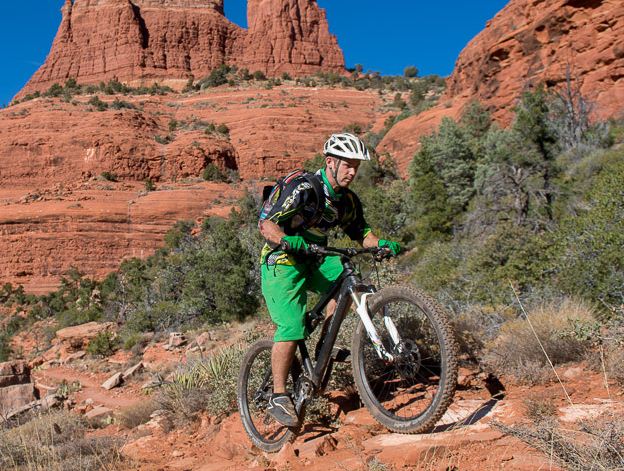
Liteville’s 301 MK10 is an elite level AM/trail bike that bristles with innovative features, most of which are camouflaged by its simple welded-aluminum, double-diamond frame design. Simply designed and elegantly engineered, Liteville targets the 301 at accomplished all-mountain riders who have already been to the circus and who place attributes like light weight, pedaling efficiency, and trustworthy handling over trendy materials and chassis design. As delivered, our 160-millimeter-travel 301 weighed 26.63 pounds (11.66 KG) without pedals and a medium-sized frame reportedly comes in at 5.34 pounds (2450 grams). Inside the 301 MK10 Chassis
Liteville 301 MK10

Liteville 301 MK10 Details:• Purpose: All-mountain, Trail, Enduro racing | • Fork (furnished): RockShox Revelation WC Black Box 150mm stroke • Accessories: Syntace SCS integrated chainguard and P6 seatpost • 180mm minimum brake-rotor diameter, post-mount brakes • Six sizes from X-small to XX-large • Variable geometry, specific to each frame size • Wheel-diameter options for extreme frame sizes • Tires up to 2.5 inches (all brands) • Color options: Anodized black, natural aluminum or white. • Five-year unconditional plus five-year 50-percent crash warranty • Frame weight (medium): 2800 grams with shock • MSRP $2723 USD (frame, shock, headset and X-12 axle) |
Liteville engineers achieved weight figures comparable to its carbon-fiber-framed competitors by first scrutinizing and then redesigning every aspect of the frame and its key components to work together as a system. Liteville’s tapered head tube arrangement can be adapted for straight, 1 1/8-inch steerer tubes. Horst-link dropouts and a slick-looking optional derailleur bash guard by Syntace.

About That Suspension
Liteville’s four-bar rear suspension actuates the 301’s signature top-tube rocker link which drives the shock into a welded boss near the seat-tube junction. The unusual arrangement is designed to use suspension forces to counter natural load-pathways in the frame, so stress is actually reduced in the top tube and seat tube area. Liteville configured the 301 linkage to deliver efficient pedaling action while the shock is set to its most active mode. The 301 MK10 can be configured with 140 or 160 millimeters of suspension travel via interchangeable rocker links. Custom Geometry

Liteville went to great lengths to ensure that the 301 will fit riders of any stature. Many riders differ in leg length and torso proportions, so Liteville keeps the top tube low throughout the size range and keeps the tapered head tube low to offer riders a choice of top tube lengths without sacrificing the bike’s stand-over clearance. For tall riders, or those with longer legs, Liteville uses a
triangulated brace at the seat tube/top tube junction, and is designed to work with Syntace’s oversize, 34.9-millimeter seat post to prevent unwanted flexing between the rider and the bike. The 74-degree seat tube angle puts the rider’s weight forward, which helps to pin the front tire to the ground while cornering, and keeps the bike in control while climbing technical sections. Liteville’s sizing system allows riders to tune their wheelbase by shopping top tube lengths and choosing a larger or a smaller frame. For those who sweat the small details, Liteville posts separate geometry charts for the 301 for 140 and 160-millimeter configurations and forks with either 545 (our test bike) or 565-millimeter axle-to-crown measurements.

To showcase the 301’s intended purpose, Syntace built our test bike specifically as an all-mountain/trail bike. Front suspension was handled by a 150-millimeter-stroke RockShox Revelation fork, spaced to 545 millimeters. The 301 rolled on 2.35-inch Schwalbe Hans Dampf tires mounted to Syntace’s new 35-millimeter-wide W35 MX wheels. Liteville 301 MK 10 Trail Test
The chassis feels longer and its steering is slightly slower than the most popular 26-inch-wheel all-mountain designs. Full-time suspension action was a plus over Sedona’s chunky trails. Upgrading to the 2.35-inch Schwalbe Hans Dampf tires that Liteville sent us, however, made the bike run around corners like it was on rails. We had many opportunities to test the Liteville’s straight-line climbing and braking traction during the test period with similar results. Suspension report: With high-volume tires and nearly a third of its 160-millimeter rear suspension sagged, the 301 rides like a leather sofa. Typically, the formula for optimum big-hit suspension performance would be to choose a fork with a slightly longer stroke than the rear suspension travel, but the extra measure of sag that Liteville builds into the 301’s 160-millimeter-travel rear end proved to be a near-perfect match for the 150-millimeter RockShox fork.

Component Report:
• Syntace X12 through-axle system is a major plus, but its Allen-key removal could be a time waster should one flat in competition.
• Syntace bash guard on Shimano’s XTR crankset is one of the nicest two-by setups we’ve used.
• W35 MX wheels, at 1680 grams are a performance enhancer for those seeking lightweight wheels with big-bike traction.
• Oversized P6 seatpost design requires a shim to mount a dropper post.
• Dedicated head tube bearings may not allow an adjustable-angle headset for those who must have that option.
• Syntace’s Rear derailleur bash guard could be a cash-saver in rocky terrain.
• Twelve-degree pull-back of the Vector Carbon handlebar effectively reduces the bike’s stem length 10 to 20 millimeters.

